



Another Color: Phelsuma
By Doug Johnston
Citation:
Johnston, D. (2002). A Bugs Nutrition. Chameleons! Online E-Zine, September 2002. (http://www.chameleonnews.com/02SepJohnston.html)
Another Color: Phelsuma
Introduction
I'm a relative newcomer to the world of reptile keeping and breeding. I started in 1996 (at my wife's urging), and soon developed an interest in Phelsuma, moving quickly into chameleons. Phelsuma fascinated me because these lizards that the late Sean McKeown dubbed "the living jewels of the islands of the Indian Ocean" were active and some even seemed curious of activity outside their enclosures. I still raise both chameleons and Phelsuma. With success keeping and breeding both, I've had offspring into F2 and even F3 in a couple cases. Any chameleon keeper will find that the techniques that allow them to keep chameleons successfully can be easily modified for Phelsuma.
And, before you start thinking about setting up a mixed species environment, be advised that chameleons regularly prey on Phelsuma in the wild. Of course there have been a few folks who keep one of the larger species of Phelsuma with a smaller or midsized chameleon, but most knowledgeable herpetologists recommend against it. You should also realize that Phelsuma are very quick and will escape from their enclosures quickly if you aren't paying attention. With their breakaway tails (they will grow back, but never as nice as the original) and their fragile skin, they are display animals not animals to be held and displayed from your hands.
Description
Lizards of the genus Phelsuma, commonly called day geckos, all lack eyelids. They all have toe pads, consisting of tiny lamellae, which can fit into irregularities on almost any surface. This makes it possible for them to easily climb any surface, including glass. There is little sexual dimorphism in most species; the males can usually be identified by their well developed femoral pores. Unlike most other members of family Gekkonidae, day geckos are diurnal (active primarily during the day). Most Phelsuma are about 4 inches to 5 inches in total length, but there are a few species that are smaller. There are even a few species whose total length reaches about 12 inches.
With only a couple exceptions, Phelsuma are found on Madagascar and other subtropical and tropical islands of the Indian Ocean. One species inhabits the Andaman Islands in the Bay of Bengal. Both P. abotti and P. dubia have been reported in Tanzania.
Basic Husbandry
Phelsuma kept in captivity are typically kept in vertically oriented glass tanks, with screen tops, in the US. They also thrive in screen or mixed cages of glass/plastic and screen. The typical vivarium I build has potting soil substrate with live plants planted in it, with a thin layer of medium or fine orchid bark covering it. I like to use sansevaria, pothos, corn plants and others. Cork bark and live moss also make for nice decorations. For some excellent examples of vivaria suitable for Phelsuma, check out some of Rex Searcy's columns in Reptiles magazine. There are also good examples in the books referenced below. The more space you can give your Phelsuma, the better off they will be. However, pairs of the medium and smaller species do very well in 20 gallon tall tanks.
Phelsuma have very similar light requirements to chameleons. I always have UV producing light such as the Reptisun 5.0. I'll often add a second fluorescent tube such as a Philips TL950, an Ott Natural Light Supplement or a GE Sunshine bulb. Also similar to chameleons, Phelsuma must be allowed to thermoregulate themselves by moving to areas of the tank with different temperatures. Ideally, you should locate your Phelsuma enclosures in a room that reaches the 80sF during the day and drops into the 70sF at night. They can tolerate hotter temperatures for short periods of time as long as they are allowed to cool off during the night. Likewise, they can tolerate cooler temperatures at night as long as they can warm up during the day. I provide no nighttime heat for my Phelsuma. During the winter I allow my house to drop to 55F at night. To supply a heat basking spot on larger tanks, I use small light hoods with household bulbs. On smaller tanks, I use small 12 volt dc halogen lights (10 watts or 20 watts). I've found that day geckos like lots of high quality light. Halogens put out a whiter light that tends to bring out their colors and activity levels. Be careful with your temperatures, of course. You don't want to turn your gecko tank into an Easy Bake Oven!!!
I control my light cycles with a Helix light controller attached to a light sensor in the window. The dusk/dawn simulation supplies a natural, gentle transition to the day beginning and end. The days getting shorter in the winter along with cooler ambient temperatures tend to stop any breeding behavior. This gives the females the chance to rest and replenish their reserves. Lights could be controlled with a timer, giving the Phelsuma a 12 hours on and 12 hours off cycle.
I always provide horizontal basking places in the tank, within a few inches of the top, as well as vertical spots in addition to the plants. My favorite choice for this is bamboo of varying sizes. It can be used for both vertical and horizontal furniture. In addition, open tubes with diameter slightly more than that of the gecko body, leaned up against the side of the tank, provide egg laying spots and areas where one gecko can get away from the other. One word of warning - if Phelsuma are not given horizontal basking spots close to the UV and heat sources, they will hang upside down from the top of the tank. If allowed to go on for long, this behavior will often result in a droopy or bent tail. It is of no significance from a general health perspective, but gives the gecko an odd appearance.
Eating and Drinking
Phelsuma are dew lappers. They don't usually drink from standing water but rather from drops on plant leaves or the surface of the tank. To supply their hydration needs, I mist their tanks rather heavily at least twice a day. I've experimented with water fountains in gecko vivaria, but have found them to be more trouble than they're worth!!! If not kept scrupulously clean, they are bacteria farms that can cause health problems for your geckos. An automatic misting system would be wonderful as long as you can handle runoff in your enclosure.
Similar to chameleons, Phelsuma are insectivores. Crickets of appropriate size (no longer than the width of the head) are a staple food source. They will also eat meal worms, wax worms, etc. as long as they are not too large. I've found that the larger species relish Zophobas, and will often learn to take them from your fingers. Be careful when you do this as the opportunity to escape is there and they do become quite aggressive and have even nipped me and drawn blood on rare occasions! Flying insects can also be a treat for the geckos and provide you with some entertainment while they leap all over the tank trying to catch them. Insecticide-free "meadow plankton" would add healthy variety.
Gut loading feeder insects is always a good idea. Feeding crickets straight from the breeder or the pet store is not advisable as these insects are dehydrated, starved and nutritionally worthless! Supplementation is an issue that most breeders feel very strongly about, but don't like to talk about. Personally, I do supplement, but not as much as when I first started. I particularly supplement breeder females (and their live-in mates) and hatchlings. I try to be careful with fat soluble vitamins such as A and D3, using only supplements that have lower levels of them.
Most Phelsuma also lick fruit nectar. A welcome dietary supplement is a slurry made from fruit baby food (I use apricot and/or tropical fruit blend), bee pollen and/or honey and other ingredients. I supply this to all my Phelsuma once or twice a week. I place a little dab on a film canister top, and leave in the tank until eaten or dried up.
Breeding
For breeding purposes Phelsuma are usually housed in single male/female pairs. There are a few species where a single male can be kept with multiple females, but multiple males must never be housed together! As always when putting together a group to cohabit or breed, pay close attention to the animals while they are getting used to each other. On occasion, aggressive behavior can be detected between individuals. Injury or death will result if geckos that don't get along are left together.
If you intend to breed your Phelsuma, make sure you have egg laying sites in the enclosure. Phelsuma lay two eggs in a clutch. Eggs are often visible within the female's abdomen just prior to laying. The eggs exit the female's body relatively soft and pliable. She will then hold and shape the egg until it hardens. The second egg is then laid against the first, resulting in them being bonded together. They will often lay them at the base of bromeliads or in the interstices of vertically oriented plants. They will also lay in bamboo tubes if supplied. I've even had a couple P. lauticauda (Gold Dust day gecko) dig and bury their eggs in the tank substrate. There are a few species that are "egg gluers", cementing their eggs to a surface where they must remain until they hatch. Since most Phelsuma will view new hatchlings as potential food, it is wise to remove the eggs and incubate them. Glued eggs should be protected if possible by taping a small plastic box over and around them. There should be some moist sphagnum moss in the box. I've incubated eggs very successfully by placing them on film canister tops resting on moist (but not wet) vermiculite in a deli cup with a few pin holes punched in the top. The eggs should not be placed directly in the vermiculite. I only add water if the vermiculite has completely dried out. I usually incubate at 80F constant in a Hovabator type incubator. There is evidence that incubation temperatures drive the sex of the resultant hatchling. However, varying the incubation temperatures between 77F and 85F should result in an even distribution of male and female hatchlings. Depending on species and incubation temperatures, fertile eggs should hatch in 38-90 days. Most females will lay a clutch every 3-4 weeks. Supplying a small dish of plain calcium during the breeding season will help the females with their bodily needs.
Some breeders feel that hatchling Phelsuma are extremely sensitive and treat them very carefully the first few weeks of their lives. I've found them to be very hardy generally and tend to treat them just like I do the adults. I do place them in smaller planted enclosures and feed them with appropriate sized prey, but otherwise they are treated just like the adults. When new hatchlings are found in the incubator, I transfer them carefully (they are tiny!) to their enclosures. I usually house clutch mates together for the first couple months (keep an eye out for aggression and different growth rates. It's rare, but does happen). I supply them immediately with a small dish of fruit baby food mixture. I also place a small number of pinhead crickets and/or flightless fruit flies. Too many prey insects can stress the hatchlings and they won't eat. Larger species will start with larger insects, of course. You will be amazed at how fast Phelsuma grow! Many species reach sexual maturity at 6 months or so, but I usually don't breed them until they reach close to a year of age.
I've recently experimented with leaving P. standingi eggs in situ with the parents. They have been reported to tolerate the hatchlings, at least until they approach sexual maturity. In my experience, two of my three breeder pairs do tolerate them. The third pair has eaten every hatchling. When they do tolerate them, you will often find one of the adults basking under the heat lamp in the morning with several hatchlings piled all over them. Very cute!
Obtaining Phelsuma
Obtaining quality Phelsuma can be a trial. There are several species still exported from Madagascar. Pet stores, if they have any Phelsuma at all, might have P. lauticauda (Gold Dust day gecko), P. lineata (Lined day gecko) or P. quadriocellata (Peacock day gecko). Most often these animals are wild caught (wc), not in the best of shape and can be difficult to acclimate. Their survival is questionable, even for experienced keepers. Specialty reptile stores will sometimes carry larger species such as P. standingi (Standings day gecko) and P. madagascariensis grandis (Madagascar giant day gecko). Not easy to find, but one of my personal favorites is P. klemmeri (Yellow-headed or Neon day gecko). I always recommend you obtain captive bred (cb) Phelsuma from a reliable breeder. Regardless, new animals should be quarantined from your other animals for at least 30 - 60 days, and then introduced carefully.
So you want to try a reptile other than chameleons, and you want to be able to utilize some of the techniques you are familiar with? If you have done your research and have access to one or more of the books listed below, Phelsuma may be the answer!
Book References:
"The General Care and Maintenance of Day Geckos" by Sean McKeown (ISBN: 1882770226) Note: Out of print but well worth the effort of finding a used copy.
Barron's "Day Geckos Facts & Advice on Care and Breeding" by R.D. Bartlett and Patricia Bartlett (ISBN: 0-7641-1699-1)
"Geckoes" by Henkel/Schmidt (ISBN: 0-89464-919-1) Note: Hardcover English translation of a German text. In addition to Phelsuma, this book covers most known members of family Gekkonidae.
Internet Reference:
Global Gecko Association (http://www.gekkota.com/). Care sheets, contacts list, and a listserve with world wide membership. The GGA also publishes a journal twice a year and regular newsletters.
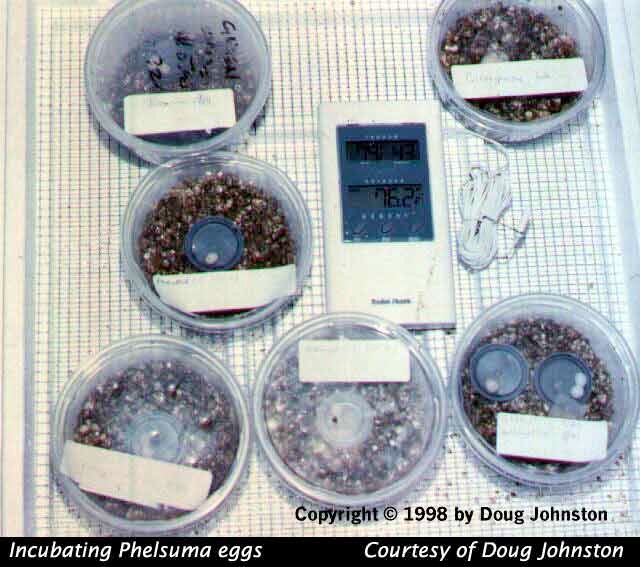
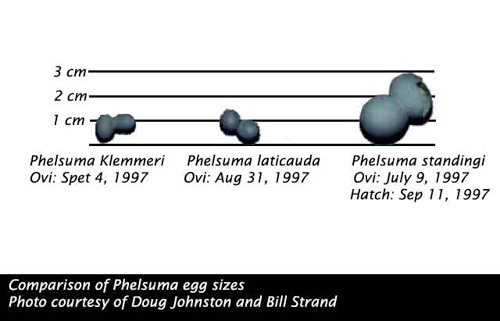
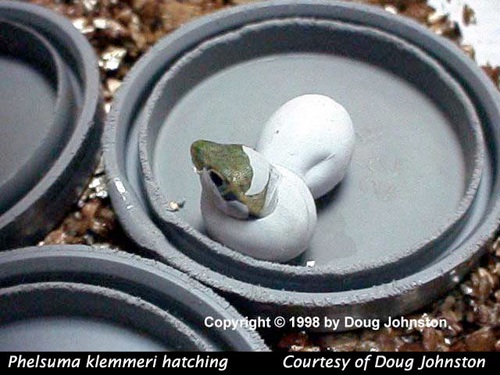
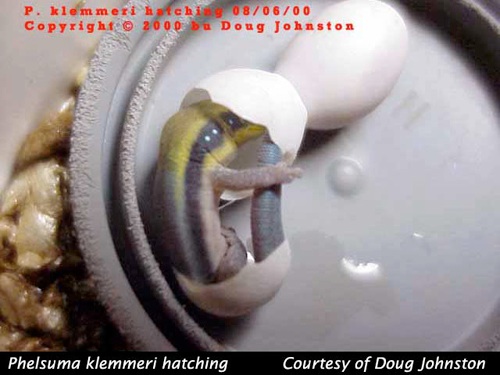
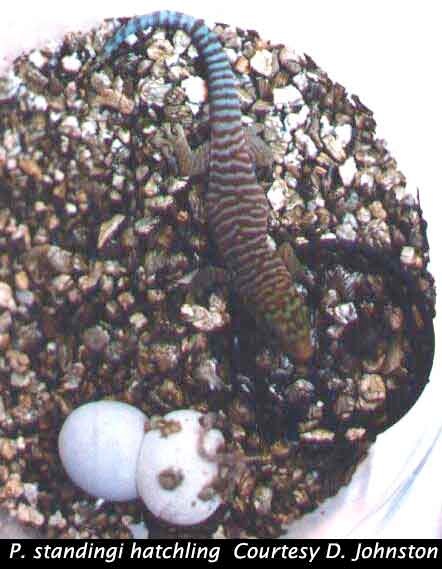
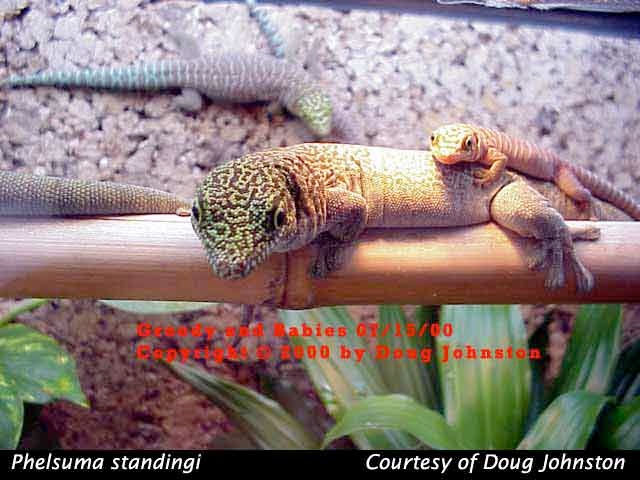
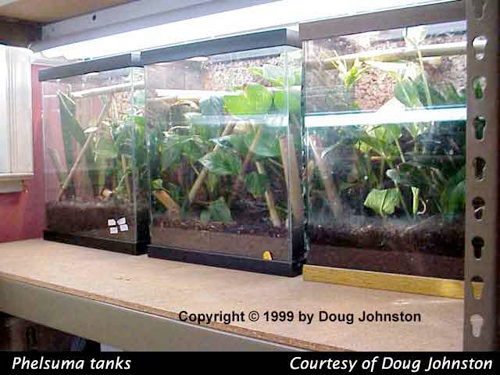
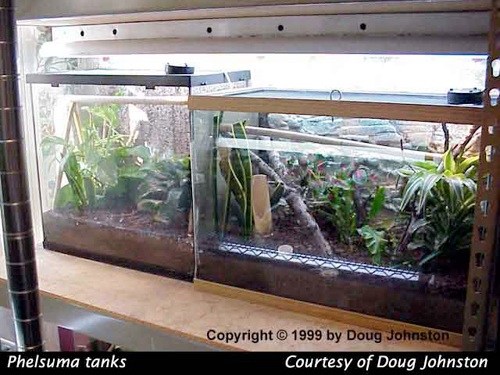
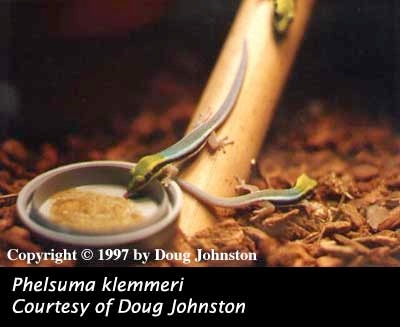
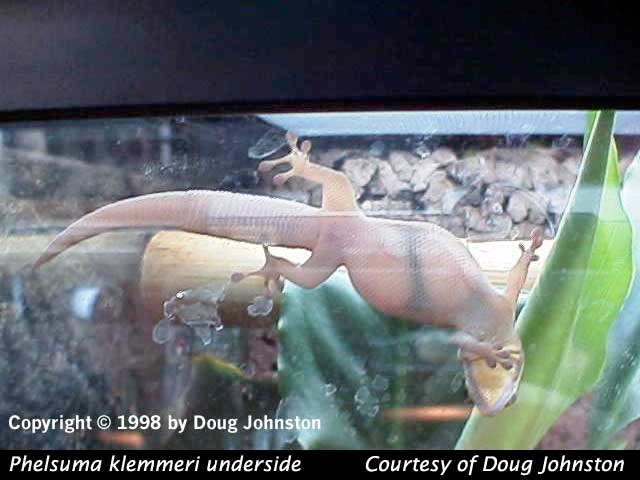
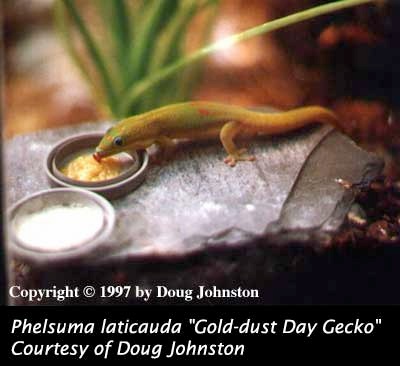
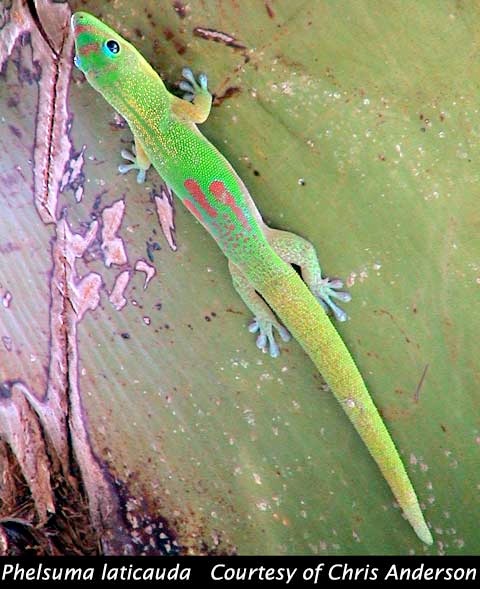
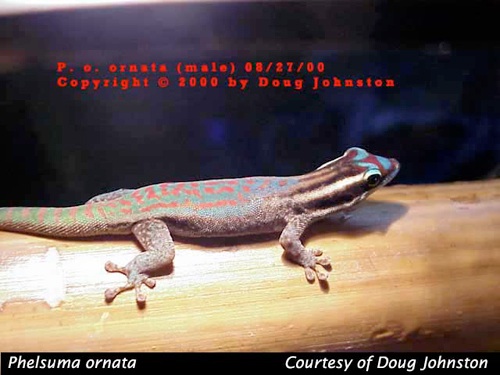
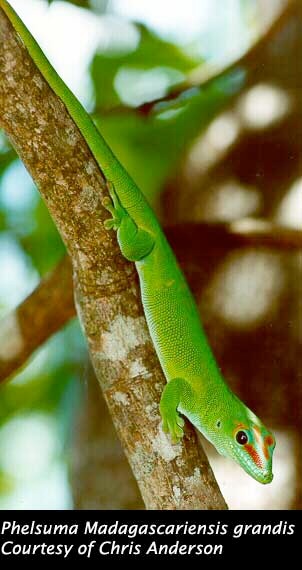
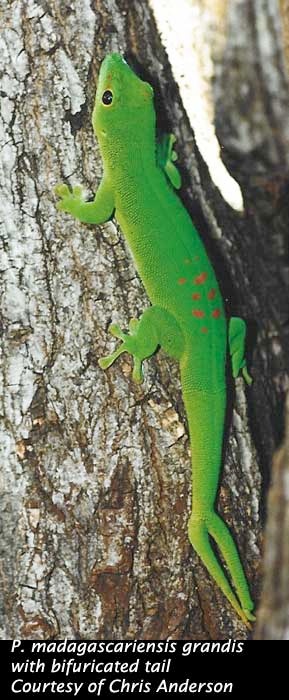
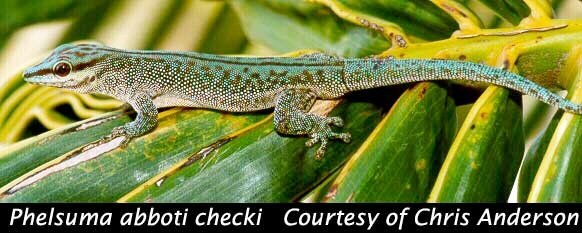
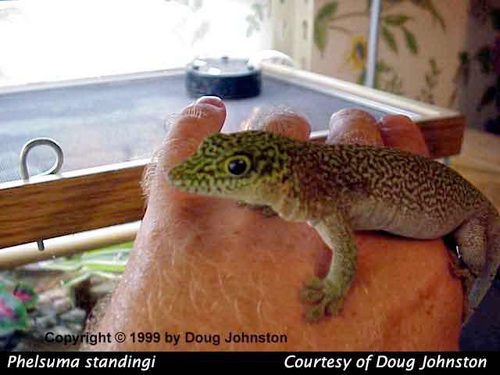
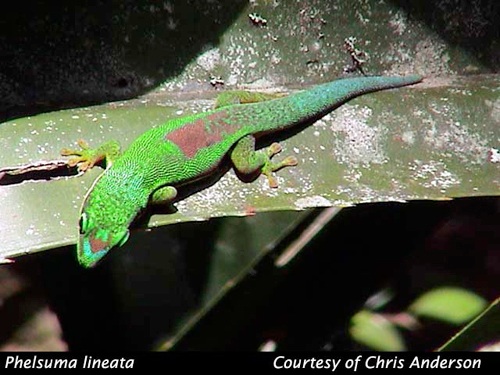

Doug Johnston

Doug Johnston, AKA “scubadug” began keeping reptiles because of his wife! A former SCUBA instructor (hence the “scubadug” moniker because 8 characters were as long as the ISP wold allow), Doug’s wife Karen wanted a lizard for Christmas. He didn’t follow through until the next summer, when she caught an alligator lizard in the front yard. The cat liberated that one and the anole came in to take it’s place but with a much better set-up. Doug proceeded to read up on the creature and found out that they were easy to breed! From there it was a glorious ride into Phelsuma and then Karen fell in love with the calyptratus. Now, with many species of chameleons and Phelsuma, anoles, Rhacodactylus, Pagona brevis, assorted insects, plus a wife and a cat, the Johnston menagerie is full!









Join Our Facebook Page for Updates on New Issues:
© 2002-2014 Chameleonnews.com All rights reserved.
Reproduction in whole or part expressly forbidden without permission from the publisher. For permission, please contact the editor at editor@chameleonnews.com
